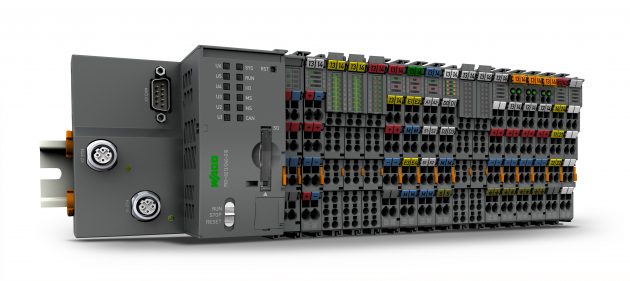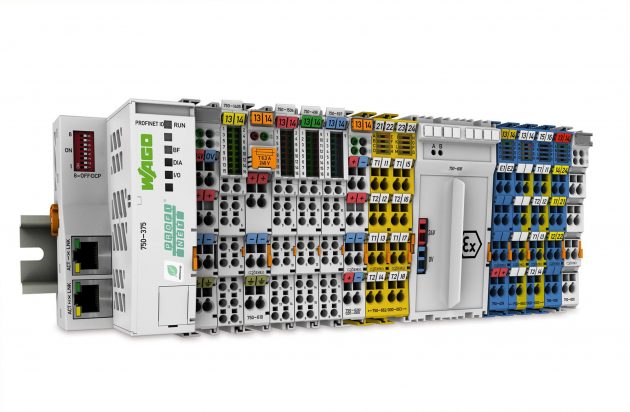
In the field of control engineering, it’s necessary to be able to quickly and accurately tune the process parameters of control loops. Process values are continuously calculated by using P (Proportional), I (Integral) and D (Derivative), or PID.
The goal of any process system is to maximize system performance while keeping process parameters within application limits. Control engineers rely on the time tested PID control feedback loop to tackle most control applications. This mathematical function enables engineers to tune their processes, meaning they are able to more precisely control their system’s efficiency and performance. By selecting the best values for P, I and D, the control function solidifies the required characteristics of the system.
Want to see other articles on Automation? Click here to download our new Automation Handbook.
Selecting these three values comes from experience and is a bit of an art form. It can be a tricky business to control a process loop to meet specific application expectations. Engineers must first know if their system is overdamped, critically damped or underdamped. They also need to know the process parameters of what they are trying to achieve. Should the loop be tuned primarily for speed with error, i.e, the difference between set points and actual values being a secondary concern, or should the loop be tuned without overshoot, with speed being a secondary consideration?
Many engineers follow guidelines developed in 1942 by Ziegler and Nichols to help tune their PID loops. This method of loop tuning usually results in a system with a quarter wave decay (a small amount of oscillation) which may be acceptable for some applications, but may not be optimal for others. An alternate set of guidelines developed by Chien-Hrones and Reswick is known as CHR tuning. CHR tuning offers methods for loops with either 20 percent overshoot or without overshoot for applications that cannot withstand going over the set point.
Commissioning of systems can be time consuming and sometimes frustrating; especially if the selected three values of PID do not meet expectations. Fine tuning these loops without the aid of an automated autotune application can be a cumbersome and costly trial-and-error process.
 Fortunately, modern control systems offer PID loops with autotune functions built-in. These functions still require the controls engineer to understand the process and application objectives, but streamline the tuning process. An autotune function not only tests the system by monitoring the response based on a series of set point changes, which are triggered by varying conditions, such as step changes or pulse changes, but also analyzes the actual value response of the system itself. From this data the P, I and D values are automatically calculated.
Fortunately, modern control systems offer PID loops with autotune functions built-in. These functions still require the controls engineer to understand the process and application objectives, but streamline the tuning process. An autotune function not only tests the system by monitoring the response based on a series of set point changes, which are triggered by varying conditions, such as step changes or pulse changes, but also analyzes the actual value response of the system itself. From this data the P, I and D values are automatically calculated.
Using a PLC controller with autotune features can save engineers valuable time when commissioning a system. Plus, it results in control loops that perform at high levels while meeting all pertinent application requirements. Using autotune can be very helpful in systems that have frequent system changes, like in a prototype. When the process is reconfigured, the characteristics are changed and then the PID loops may need to be re-tuned. Using autotune can make this process much faster.
e!COCKPIT software is a programming tool for WAGO’s performance class PFC controllers that offers several proven methods of autotuning PID loops for a multitude of applications. Using either the principles of Ziegler and Nichols, or those of Chien-Hrones and Reswick, the WAGO autotune feature allows the user to adapt their processes based on the type of loop that is used in the application. These streamlined applications come at a time when there are fewer and fewer engineers working in the field. This software helps over-burdened engineers who may be managing multiple assignments to efficiently find time to complete and manage all their projects. See more on e!COCKPIT engineering software and try it free for 30 days here.
 There are many applications where this can apply such as in the food, beverage, and pharmaceutical industries. Many products in these applications can be considered flammable and considered hazardous materials. In these applications, engineers can use intrinsically safe input and output modules to control the processes without worrying about an ignition point. Using WAGO’s blue intrinsically safe modules (pictured above) with analog inputs can be combined with the autotuning PID to configure process control. Learn more about
There are many applications where this can apply such as in the food, beverage, and pharmaceutical industries. Many products in these applications can be considered flammable and considered hazardous materials. In these applications, engineers can use intrinsically safe input and output modules to control the processes without worrying about an ignition point. Using WAGO’s blue intrinsically safe modules (pictured above) with analog inputs can be combined with the autotuning PID to configure process control. Learn more about
Other applications that take place in harsh outdoor environments, such as mining or pipeline, call for controllers that can withstand extreme temperatures and vibration. WAGO’s eXTReme product line has the solution: industrial controllers with an operating temperature of -40 C to +70 C. They are also shock resistant up to 5g with the ability to endure normal condensation. These devices are offered with analog input and outputs, and can also leverage the e!COCKPIT-based PID autotuning feature.
To learn more about our intrinsically safe and eXTReme product lines, click here.
Print this page
Advertisement
- Cannabis-infused drinks struggle with production, distribution
- Compact 1,500 watt integrated servo motor
Using PID control feedback to maximize system performance
Don Horne
Process West features pw featureIn the field of control engineering, it’s necessary to be able to quickly and accurately tune the process parameters of control loops. Process values are continuously calculated by using P (Proportional), I (Integral) and D (Derivative), or PID.
The goal of any process system is to maximize system performance while keeping process parameters within application limits. Control engineers rely on the time tested PID control feedback loop to tackle most control applications. This mathematical function enables engineers to tune their processes, meaning they are able to more precisely control their system’s efficiency and performance. By selecting the best values for P, I and D, the control function solidifies the required characteristics of the system.
Want to see other articles on Automation? Click here to download our new Automation Handbook.
Selecting these three values comes from experience and is a bit of an art form. It can be a tricky business to control a process loop to meet specific application expectations. Engineers must first know if their system is overdamped, critically damped or underdamped. They also need to know the process parameters of what they are trying to achieve. Should the loop be tuned primarily for speed with error, i.e, the difference between set points and actual values being a secondary concern, or should the loop be tuned without overshoot, with speed being a secondary consideration?
Many engineers follow guidelines developed in 1942 by Ziegler and Nichols to help tune their PID loops. This method of loop tuning usually results in a system with a quarter wave decay (a small amount of oscillation) which may be acceptable for some applications, but may not be optimal for others. An alternate set of guidelines developed by Chien-Hrones and Reswick is known as CHR tuning. CHR tuning offers methods for loops with either 20 percent overshoot or without overshoot for applications that cannot withstand going over the set point.
Commissioning of systems can be time consuming and sometimes frustrating; especially if the selected three values of PID do not meet expectations. Fine tuning these loops without the aid of an automated autotune application can be a cumbersome and costly trial-and-error process.
 Fortunately, modern control systems offer PID loops with autotune functions built-in. These functions still require the controls engineer to understand the process and application objectives, but streamline the tuning process. An autotune function not only tests the system by monitoring the response based on a series of set point changes, which are triggered by varying conditions, such as step changes or pulse changes, but also analyzes the actual value response of the system itself. From this data the P, I and D values are automatically calculated.
Fortunately, modern control systems offer PID loops with autotune functions built-in. These functions still require the controls engineer to understand the process and application objectives, but streamline the tuning process. An autotune function not only tests the system by monitoring the response based on a series of set point changes, which are triggered by varying conditions, such as step changes or pulse changes, but also analyzes the actual value response of the system itself. From this data the P, I and D values are automatically calculated.
Using a PLC controller with autotune features can save engineers valuable time when commissioning a system. Plus, it results in control loops that perform at high levels while meeting all pertinent application requirements. Using autotune can be very helpful in systems that have frequent system changes, like in a prototype. When the process is reconfigured, the characteristics are changed and then the PID loops may need to be re-tuned. Using autotune can make this process much faster.
e!COCKPIT software is a programming tool for WAGO’s performance class PFC controllers that offers several proven methods of autotuning PID loops for a multitude of applications. Using either the principles of Ziegler and Nichols, or those of Chien-Hrones and Reswick, the WAGO autotune feature allows the user to adapt their processes based on the type of loop that is used in the application. These streamlined applications come at a time when there are fewer and fewer engineers working in the field. This software helps over-burdened engineers who may be managing multiple assignments to efficiently find time to complete and manage all their projects. See more on e!COCKPIT engineering software and try it free for 30 days here.
 There are many applications where this can apply such as in the food, beverage, and pharmaceutical industries. Many products in these applications can be considered flammable and considered hazardous materials. In these applications, engineers can use intrinsically safe input and output modules to control the processes without worrying about an ignition point. Using WAGO’s blue intrinsically safe modules (pictured above) with analog inputs can be combined with the autotuning PID to configure process control. Learn more about
There are many applications where this can apply such as in the food, beverage, and pharmaceutical industries. Many products in these applications can be considered flammable and considered hazardous materials. In these applications, engineers can use intrinsically safe input and output modules to control the processes without worrying about an ignition point. Using WAGO’s blue intrinsically safe modules (pictured above) with analog inputs can be combined with the autotuning PID to configure process control. Learn more about
Other applications that take place in harsh outdoor environments, such as mining or pipeline, call for controllers that can withstand extreme temperatures and vibration. WAGO’s eXTReme product line has the solution: industrial controllers with an operating temperature of -40 C to +70 C. They are also shock resistant up to 5g with the ability to endure normal condensation. These devices are offered with analog input and outputs, and can also leverage the e!COCKPIT-based PID autotuning feature.
To learn more about our intrinsically safe and eXTReme product lines, click here.
Print this page